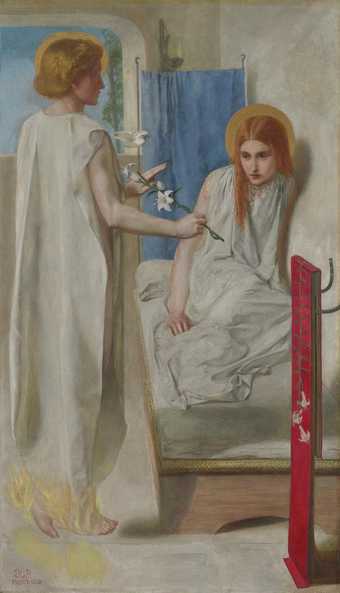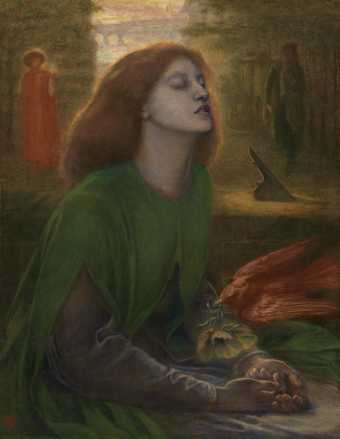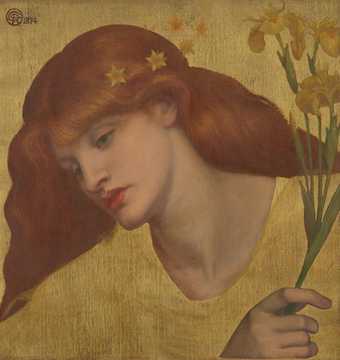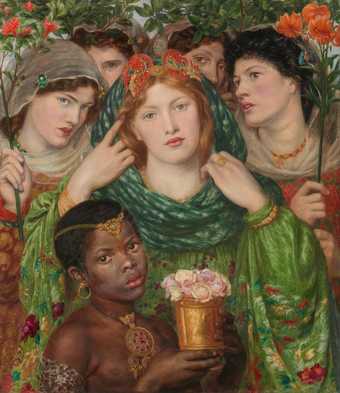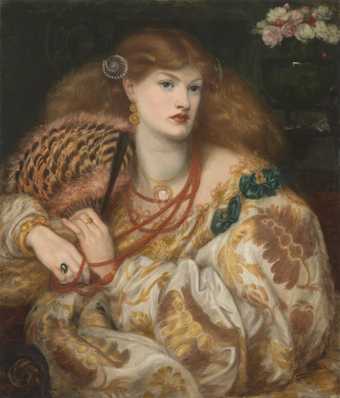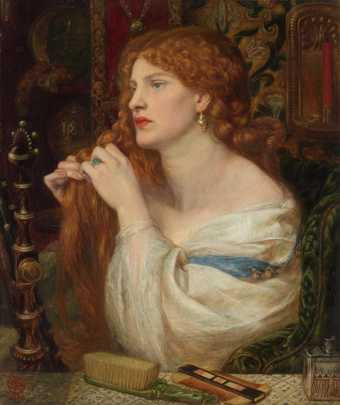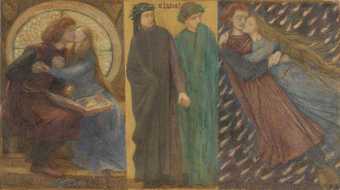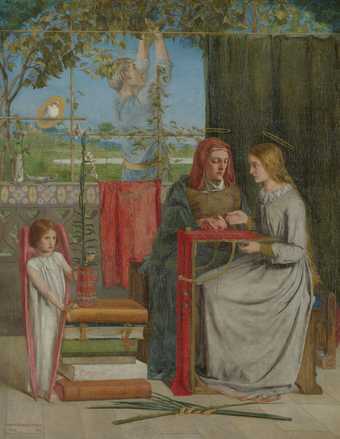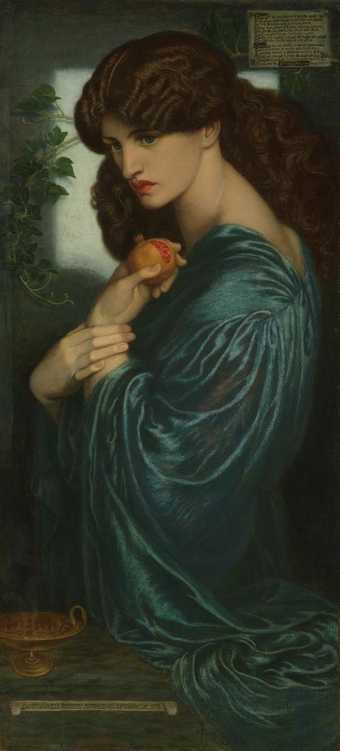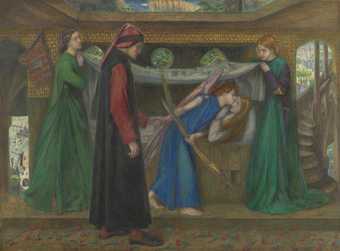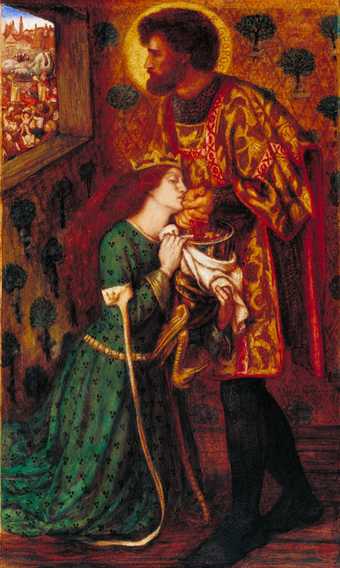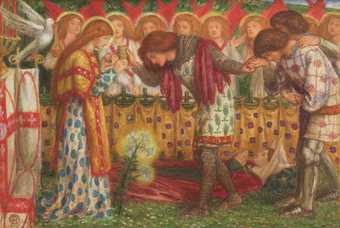
In Tate Britain
Exhibition
- Artist
- Dante Gabriel Rossetti 1828–1882
- Medium
- Oil paint on mahogany
- Dimensions
- Support: 749 × 813 mm
frame: 965 × 1019 × 61 mm - Collection
- Tate
- Acquisition
- Presented by F. Treharne James 1920
- Reference
- N03532
Summary
This painted panel decorated one of three cupboard doors that formed the upper part of a large settle belonging to William Morris (1834-96). The subject of all three panels was Beatrice Portinari, for whom the medieval Italian poet Dante Alighieri (1265-1321) nurtured an enduring but unrequited love, as recounted in the Vita Nuova. Rossetti was fascinated by Dante's story -which he translated for his own publication, The Early Italian Poets (1864) - and saw in it a parallel with his own love for Lizzie Siddal.
Dantis Amor (Dante's Love) is the central panel, symbolising Beatrice's death, which occurred between the events depicted in the other two panels, The Salutation of Beatrice in Florence and The Salutation in the Garden of Eden (both in the National Gallery of Canada, Ottawa).
The settle was apparently painted dark red, which would have provided a rich setting for Rossetti's boldly schematic designs. Rossetti presented the two Salutation panels to Morris as a wedding present. The earthly Beatrice in the first panel was modelled on Morris's new wife Jane Burden, with whom Rossetti was also smitten. The heavenly Beatrice in Dantis Amor, however, is modelled on Lizzie Siddal. In this respect, the picture prefigures Rossetti's later visionary representation of Lizzie in Beata Beatrix (Tate N01279).
The picture is intended to depict Beatrice's death and subsequent union with Christ. The scene is divided diagonally, with the haloed figure of Christ looking down from the top left towards Beatrice, enclosed in a crescent moon and surrounded by stars. The central angel holds a sundial, as yet unfinished, but which, in the preparatory drawing (Birmingham City Art Gallery), indicates the number nine, the hour of Beatrice's death. In the drawing Rossetti also inscribed along the line of the diagonal the concluding words of Dante's Divine Comedy: 'L'AMOR QUE MVOVE IL SOLE E L'ALTRE STELLE' [the love which moves the sun and the other stars] (Paradiso xxxiii, l.145). The composition is thus intended to represent not only the death of Beatrice and her transition from earth to heaven, but the wider notion that love is the generating force of the universe.
Despite the realistic representation of the figures, the patterned background is unusually stylised, and it has been suggested that another artist may have intervened in this section of the panel. Some areas remain unfinished; for example, the crescent moon enclosing the Head of Beatrice was to have been inscribed with lines from La Vita Nuova: 'QVELLA BEATA BEATRICE CHE MIRA CONTINVAMENTE NELLA FACCIA DI COLVI' [that Blessed Beatrice who continuously gazes at Him.' The lines carry on into Christ's halo: 'QVI EST PER OMNIA SAECVLA BENEDICTVS' [Who is blessed throughout eternity].
Further reading:
Leslie Parris (ed.), The Pre-Raphaelites, exhibition catalogue, Tate Gallery, London 1984; reprinted 1994, pp.179-80, reproduced p.180, in colour.
Virginia Surtees, The Paintings and Drawings of Dante Gabriel Rossetti (1828-1882): A Catalogue Raisonné, 2 vols., Oxford 1971, pp.70-1, no.116, reproduced pl.172.
Andrew Wilton and Robert Upstone (eds), The Age of Rossetti, Burne-Jones & Watts - Symbolism in Britain 1860-1910, exhibition catalogue, Tate Gallery, London 1997, pp.135-6, reproduced p.135, in colour.
Frances Fowle
December 2000
Does this text contain inaccurate information or language that you feel we should improve or change? We would like to hear from you.
Display caption
This was one of three panels painted by Rossetti to decorate the upper part of a settle belonging to William Morris. The subject for all three was Dante’s La Vita Nuova which Rossetti translated for his own publication, The Early Italian Poets 1861. Rossetti was fascinated by Dante’s story and saw in it a parallel with his own love for Elizabeth Siddall. Dantis Amor (Dante’s Love) is the central panel, symbolising Beatrice’s death, which occurred between the events depicted in the other two panels, The Salutation of Beatrice in Florence and The Salutation in the Garden of Eden.
Gallery label, November 2016
Does this text contain inaccurate information or language that you feel we should improve or change? We would like to hear from you.
Explore
- literature and fiction(3,138)
-
- characters(438)
-
- Beatrice(14)
- literature (not Shakespeare)(2,276)
- scientific and measuring(791)
-
- sundial(19)
- actions: postures and motions(9,111)
-
- standing(3,106)
- head / face(2,497)
- individuals: female(1,698)
- Bible: New Testament(545)
-
- Christ(281)
- Heaven(53)
- angel(267)
- birth to death(1,472)
-
- death(685)
You might like
-
Dante Gabriel Rossetti Ecce Ancilla Domini! (The Annunciation)
1849–50 -
Dante Gabriel Rossetti Beata Beatrix
c.1864–70 -
Dante Gabriel Rossetti Sancta Lilias
1874 -
Dante Gabriel Rossetti The Beloved (‘The Bride’)
1865–6 -
Dante Gabriel Rossetti Monna Vanna
1866 -
Dante Gabriel Rossetti Aurelia (Fazio’s Mistress)
1863–1873 -
Dante Gabriel Rossetti Paolo and Francesca da Rimini
1855 -
William Holman Hunt Claudio and Isabella
1850 -
Dante Gabriel Rossetti St Catherine
1857 -
Dante Gabriel Rossetti The Girlhood of Mary Virgin
1848–9 -
Dante Gabriel Rossetti Proserpine
1874 -
Dante Gabriel Rossetti Dante’s Dream at the Time of the Death of Beatrice
1856 -
Dante Gabriel Rossetti St George and Princess Sabra
1862 -
Dante Gabriel Rossetti Mrs Vernon Lushington
1865

